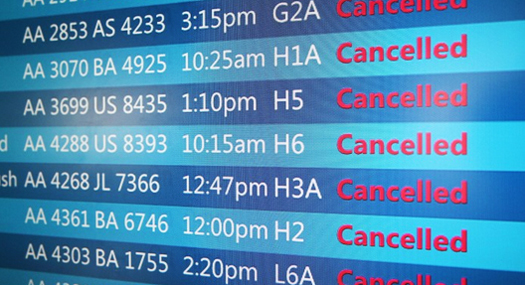Here Comes the Summer
May 15, 2022
AIRLINES are understaffed, employees are overworked, passenger volumes are back to pre-pandemic levels, masks are off. And here come the three busiest travel months of the year. We’re already at the ragged edge of the envelope; just wait until those midsummer thunderstorms start barreling in. It’s going to be messy. If you bring one thing to the airport this summer, have it be this: patience.
I’m not the only one sounding the alarm. The major media, along with all the travel blogs, have been putting out their warnings as well. I like to believe that precisely because there’s so much hype, chances are things won’t turn out as bad as everyone says. So think of this post as a kind of reverse jinx. I’ll be traveling a lot in the next few months, and would prefer to keep my frazzle levels low.
Part of the mess is due to an ongoing pilot shortage, as I’m sure you’ve heard. In fact there are two pilot shortages, the effects of which are overlapping. One is short-term and mostly the result of poor planning. The second is more systemic and longer term.
When I say “poor planning,” I’m talking about the industry’s failure to adequately re-staff as things swung back to normal. However, while on the surface the airlines look pretty stupid, it’s not that simple: Consider the environment at the height of COVOD-19 downturn. The industry had never faced anything like this, and was desperate to stay alive. There was no way of predicting when, or to what extent, flyers would return. As the virus ebbed and surged, travel restrictions and border closings changed week to week; absolutely nothing was certain, and almost nobody predicted a return to 2019 numbers so soon. The expectation, so much as there was one, was of a gradual, incremental return.
Air travel logistics are challenging enough in normal times, never mind when the entire world has flipped upside-down. When it came to aligning their fleets and staffing, they did what they calculated was the smartest thing to do. Some guessed better than others — and that’s what it was to a big degree: guesswork.
Airlines are now taking on hundreds of new-hire pilots every month. This, combined with the lingering effects of the pandemic reshuffling, finds training departments overwhelmed, with long backlogs for classroom time, simulator slots, line certification flights, and so on. Many pilots are sitting at home, waiting their turn. Thus, it’s less a dearth of pilots than a training system overload.
Then we have the other, more systemic shortage. As I talked about in this older article, this is a significantly bigger problem at the regional carrier level than at the majors. All of the biggest airlines are currently hiring, and although they’re having no trouble filling their openings, those pilots have to come from somewhere, with high requisite levels of skill and experience. This is causing a ripple effect downward through the industry. The regional sector has all but reinvented itself in a plea for pilots, offering salary and benefits packages heretofore unheard of for entry-level airline pilots.

What nobody is talking about, meanwhile, is the issue of airspace and runway saturation. This is an even bigger factor than anything related to labor. Airlines continue adding planes into a system already at maximum capacity, especially in the eastern half of the U.S. It was bad enough pre-pandemic. Now, several upstart carriers are pumping even more airplanes into the sky.
Things run fairly smoothly when the weather is good, but the minute a storm develops, blocking off air routes, the delays and cancellations start to cascade. There’s no slack, no logistical breathing room. Even on clear-weather days, the taxiway queues at airports like Newark or La Guardia can be hours long.
It’s hard to say to what impact all of this will have on the summer of 2022. Pilots are just one of the moving parts.
Things might get messy, no doubt. But try to look at the bright side: People are out and about. Borders and attractions are (mostly) open. Travel is back. I wasn’t sure we’d get here, so count me among those who are happy to see a little chaos again at the airport.
“Here Comes the Summer” is a horrible song by the Undertones. Here’s a better one.
Related Stories:
THE MELANCHOLY OF AN EMPTY AIRPORT
BIG PLANES, SHORT ROUTES. WHAT A CONCEPT.
FACT AND FALLACY OF THE PILOT SHORTAGE




Leave a Comment
Maximum 1500 characters. Watch your spelling and grammar. Poorly written posts will be deleted!
8 Responses to “Here Comes the Summer”
You are viewing newest comments first. Click to reverse order
Hey Patrick,
Can you clarify something, please? Every TV news report I see breathlessly reports that “1,300 flights were cancelled yesterday.” But they provide no context for that number. Is it 1,300 out of 13,000 flights–a 10% cancellation rate, or 1,300 out of 130,000 flights, a 1% cancellation rate? It’s like the meteorologist telling you that it’s “42 degrees outside” without specifying Celsius or Fahrenheit. Down jacket or swimming trunks?
How likely is it to affect the traveler if, due to storms or staffing, 1,300 flights are cancelled?
Thanks!
db
Impossible to argue with any Husker Du, especially from either Zen Arcade or New Day Rising, but the Undertones’ thing is also pretty good.
Re the pandemic (& according to the media), the following happened, at least here in Europe: While ruthlessly furloughing &/or firing, airlines continued to dispatch near-empty planes all over the world. Why? To keep slots. Incredible but, they say, true.
They could instead have pooled their resources & flown far fewer, but fuller, flights. The money all concerned would’ve saved could’ve been used to pay salaries, with a *lot* left over. Indeed, they were receiving massive relief from governments (same in US).
This money could’ve been far better spent, seems to me.
Must say I wasn’t aware of the near-sacred status of slots or the authorities’ unwillingness to modify the system in a crisis.
On the radio here in North Texas this morning they were talking about how Love Field is back to pre-pandemic traffic levels in terms of total passengers, but the traffic mix is different than before. Leisure travelers outnumber historical norms, but business travel still lags. Since leisure travelers tend to be either first-time customers or only occasional participants in the airport ecosystem (and they tend to be families with kids) it can put a strain on both the TSA and the gate boarding operations. If that’s true, I would be interested to read an article on your true experiences in the system. Is the slant away from “expert” travelers to novices creating problems in the terminals?
I might have said this before, but…there’s a pilot shortage?? And this time it’s for REAL?? D*mn, I was born about 30 years too early! Back when I had finally built up enough suitable flight time to apply for an airline job, the only “shortage” the airlines faced was the disappearance of all the ex-Air Force guys with 5,000+ hours of KC-135 and B-52 time. If you wanted to get a job with a regional, flying Beech 1900s or J-32s, you had to pay $10,000 – $15,000 to FlightSafety or some other training organization for your initial F/O training. You were essentially forfeiting your first year takehome pay. (And that didn’t include a type rating, just company-specific new-hire training). Having emptied my bank account for everything from Private through ATP/ME & CFI-I, I said “enough” and bowed out.
Best wishes to all the new hires in this brave new airline industry!
JetBlue wants Spirit for the pilots and planes. They will steadily drop Spirit flights and transition Spirit’s pilots and planes to JetBlue. The legacies could trade two regional flights for one mainline in many markets where there are several RJs per day. BOS-LGA for example. There are currently 16 hourly Delta/Republic flights on 70 seat RJs. They could use a 150 seat A320 or 737 every two hours. It’s not the answer but would make a dent. Or the legacies could operate all of the 60+ seat jets themselves leaving the 50 seat jets to the Regionals just as they did up to around 2000. They already own most of the 60+ seaters anyway.
Do the re-hired pilots regain their former position in the seniority, or do they have to start over?
Might be a good year to take a driving vacation.